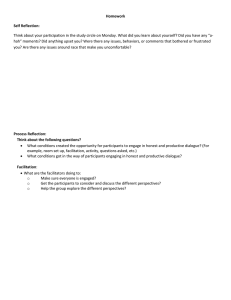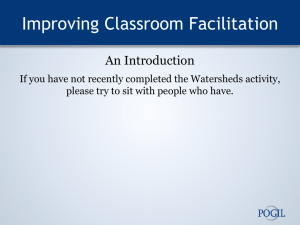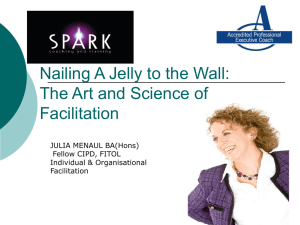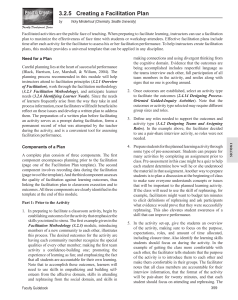Professional Facilitation Leading meetings and committees to success!
advertisement
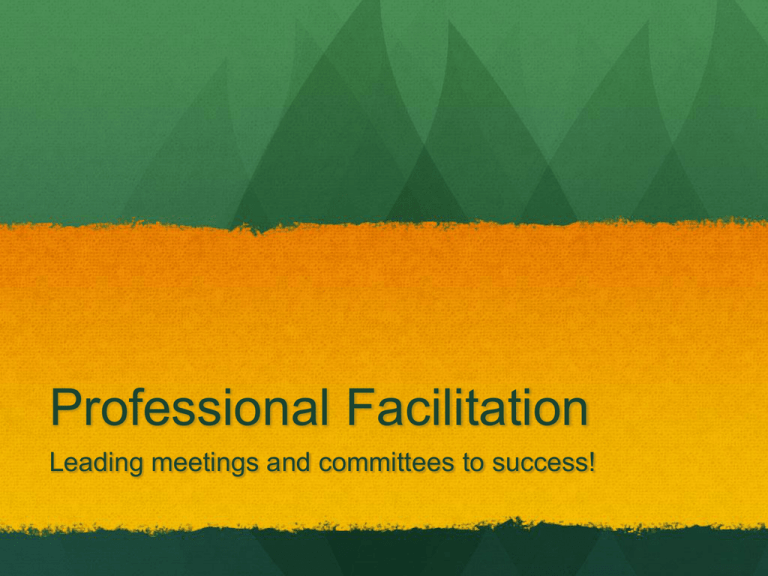
Professional Facilitation Leading meetings and committees to success! Goals of Workshop How to prepare for professional meetings Facilitating effective committee meetings Discuss empowering language that can be used during meetings Working with Committees What to do before a meeting 1.Clarify purpose and goals 2.Create an agenda 3.Make room arrangements 4.Schedule the meeting 1.Initial meeting 2 weeks in advance 2.Reminder week of meeting 5.Post and send out agenda 6.Circulate supporting information in advance Logistics! Logistics! Determine the meeting time/location How many will attend? What time/day works for most individuals involved? What do you need to do to reserve the space? Creating the agenda What needs to be discussed? What decisions need to be made? What needs to be delegated? What tasks need to be completed? What does the team/committee need to be informed about? What is coming up? What needs to be followed up on? Working with Committees What to do during a meeting 1.Start on time 2.Distribute and Review Agenda 3.Keep Discussion Focused 4.Encourage participation 5.Help Group come to decisions 6.Summarize decisions 7.Agree on action plan 8.Delegate responsibilities 9.Draft agenda for next meeting Working with Committees What to do After a meeting 1.Reserve next meeting space 2.Distribute minutes to committee 1. Key points 2. Who is responsible for what follow-up action & by when 3.Archive meeting documents 4.Complete assigned tasks 5. Send meeting reminder to committee Adding the Effective into Meetings Think about a meeting that you’ve been to lately that you consider to have been effective How do effective team meetings contribute to collaboration? Individually, list as many ideas as you can about factors that contribute to effective team meetings. In pairs of triads, talk about your ideas and identity five ideas that you and your partner consider most important to effective team meetings. Tips for Leading Effective Meetings Good structure Defines when and how groups will come together to do their work Good process Communication and related strategies that help groups organize their work. Good leadership/facilitation Promote relationship building and participation Accomplish team’s tasks Strong Structures Decide on regular meeting times Decide how meeting will be conducted (use of agendas and roles) How will decisions be made? (consensus, democratic) Identify group norms and purpose What would group norms be? Talk about how members will communicate between meetings. Productive Process Use roles and share them when possible Facilitator, timekeeper, recorder Facilitators role can be and should be shared to create a sense of equal value. Find ways to develop trust and a sense of shared responsibility Pay attention to the use of good communication skills Allow time for the group to say what they are doing well and what can be improved. Use of Agendas and timelines Come up with partial agenda and ask for input and additional items If there’s too much to do, prioritize and stick to your timelines Problem-Solving Activity Think about some times when meetings have not been effective (please do not be specific) “What happened and why you saw this as a challenge.” Group Members: Drawing on your own experiences as well as today’s discussion, generate alternatives to the situations described. Leadership & Facilitation Balance the task and relationship aspects of collaboration Focus both on getting tasks done and developing good relationships Read the energy of the group and adapt as necessary Use humor-wisely Use your role to develop a sense of equity among members Encourage participation Remind members that participation is listening and talking When necessary, step in to help resolve conflict and/or to help in doing so. Use your role as a way to identity when decisions are being made Not the difference between “discussion time” and “deciding time.” Any Questions? Common Meeting Problems Dominant Participants Silent Participants Round robin Name plates Allow individual brainstorm time Small groups Discuss in private Emphasize importance of everyone contributing Common Meeting Problems Can’t Make decisions Why does this happen? What are solutions? Create actionable agenda with clear expectations Use prioritize tools Ask for alternatives Go back to the purpose Finishing on time Why does this happen? What are solutions? Timekeeper Place topics that require more discussion at the very beginning Start meeting on time End meeting on time The art of facilitation Paraphrase Check for Meaning Check your understanding of a participant’s statement or ask the participant clarify what he or she is saying. EX: Are you saying that this plan is not realistic? I’m not sure that I understand exactly what you mean.” Give positive feedback Paraphrase what a participant has said so that he or she feels understood and provide a concise summary of statement for participants EX: So, what you’re saying is that we need to talk with AS before determining our program date? Compliment an interesting or insightful comment. EX: That’s a good point. I’m glad that you brought that to our attention.” Expand Elaborate on a participants contribution to the discussion with examples, or suggest a new way to view the problem. Basic Principles How would you define the role of the facilitator of a meeting? “Facilitator accepts responsibility to help the group accomplish a common task by moving through the agenda in the time available and to make the necessary decisions and plans for implementation.” Facilitator doesn’t make decisions for the group but suggests way to help the group move forward. Its important that each member understands they play an important role Your commitment is to the group not the individual The art of facilitation Increase the Pace Devil’s Advocate Disagree (gently) with a participants comments to stimulate further discussion EX: I can see where you are coming from, but I’m not sure what you are describing is always the case. What do you think students from AS Gov would view this problem? Relieve Tension Energize the discussion by quickening the pace, using humor, or, if necessary, prodding the group for more contributions. EX: Ok so I know we are all tired so for the next 2 minutes I want you to throw out as many programming ideas you can on the topic of Cesar Chavez. Ready go! Mediate differences of opinion between participants and relieve any tensions that may be brewing. Consolidate Pull together ideas, showing their relationship to each other. The art of facilitation Change the process Alter the method of obtaining participation or by having the group evaluate ideas that have been presented. EX: “Let’s break into smaller groups and see if you can come up with some ideas” Summarize Summarize (and record) the major views of the group.


